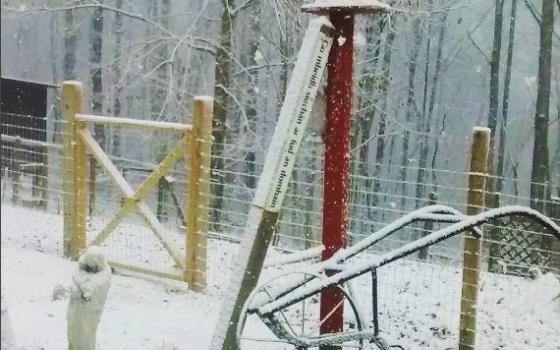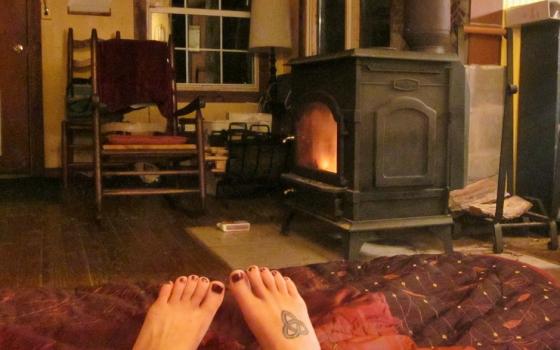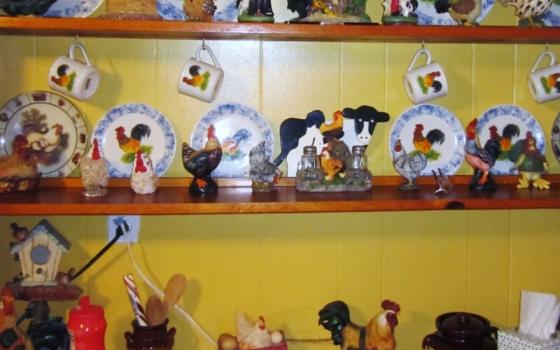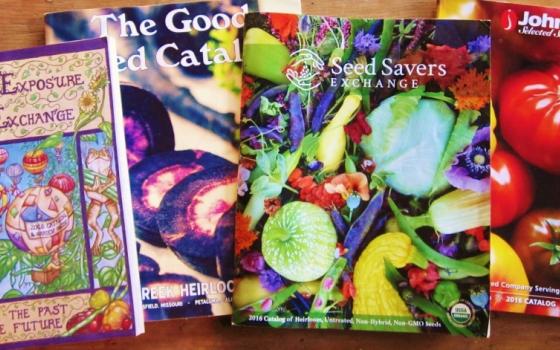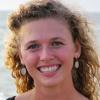Notes from the Field are reports from young women volunteering in ministries of Catholic sisters. The project began in the summer of 2015 when, working with the Catholic Volunteer Network, we enlisted four young women working in Honduras, Thailand, Ethiopia and the United States to blog about their experiences. The fall 2015 series presents two more women, both volunteering with sisters' ministries in the United States.
______
At Big Laurel Learning Center, the month of January is typically a very slow month. Wintery weather and rural isolation keep most groups away, and the shorter days keep those of us here in our homes all evening. For weeks, I have been prepping myself for this post-holiday slow period, though to be honest, my best plan was to simply hibernate through it. Just weeks ago, the January calendar was empty and open, but almost without our notice, the month began to fill up with visits and connections, both people visiting us and us visiting others.
Something to celebrate this month was a connection formed between an Ohio university and Big Laurel. Located near Columbus, the University of Dayton has an excellent school of engineering with a unique program for students called Engineers in Technical Humanitarian Opportunities of Service Learning (ETHOS).
The 10-week internship allows engineering students to live and work in developing countries to help design and implement appropriate technologies that can be used there. This program values the importance of doing more with less and acting in solidarity with people around the world through service.
It is a stellar program, but it is unobtainable for some Dayton students because they are unable to commit to spending months living abroad. The university also found it difficult to involve students in shorter "exposure" trips because of the high cost of sending students abroad for a short period of time. And that is where Big Laurel becomes useful.
Because Big Laurel's rustically appropriate technologies, such as rainwater collection systems, closely mirror the conditions at some of the sites where ETHOS students often intern, it could be a good domestic exposure site for engineering students who aren't immediately planning on going abroad.
Since my husband, Ian, made initial contact with the university months ago, we have been part of an ongoing conversation with them that culminated with some engineering professors and a few grad students making an overnight trip to our mountain home to get a sense of our property and to see what potential it had for their program.
Ian had great fun showing the academics around our property and took special pride in their enthusiasm for our 500-gallon water tank collection system. I appreciated the chance to play hostess and have our rambling house filled with people. The group left the next morning with a plan to look more intensively at our water system in the spring, but this time with curious students. Since our arrival, Ian and I have had a goal of exposing more groups to the potential that Big Laurel has, so the newfound connection with Dayton's ETHOS program is a big step in the right direction.
A less goal-oriented visit we had this month was with a college freshman from Western Kentucky University who had volunteered at summer ecology camps at Big Laurel when he was in high school and saw his extended Christmas break as an opportunity to revisit the mountain for several days. The photojournalism student hoped to gain some stories about us and the greater community of southern West Virginia. He impressed Ian and me with his audacity and willingness to put himself in potentially awkward situations to get answers to his questions, and in his short time with us, he exposed us to parts of our new community that we hadn't been involved with yet, including a nerve-wracking high school basketball game. His enthusiasm was infectious, and the opportunity to host one person rather than a group made for a pleasant change.
Expanding on this, Ian and I had the opportunity on Jan. 15 to meet with one of patriarchs of the mountain community. A true mountain man, our neighbor and his devoted wife have seven children, five of whom still live nearby. He built his own home — and the Big Laurel schoolhouse — using lumber he milled from his own land. Their four youngest children attended that school, and the couple has remained involved with community celebrations throughout the years.
Their family is marked by stability, mutual support, care and a splendid sense of hospitality open to all. Consequently, they made us feel comfortable within the first few minutes of our visit. Their home is the weekly gathering place of more than 20 grandchildren and is filled with pictures of family and numerous touches that make it evident that lives have been spent there. On our visit, Ian and our student guest seized the opportunity to watch one of the sons butcher a hog in the garage while I stayed inside to talk about the family's involvement with building our Knob house. It was a wonderful visit that rooted us into our community and gave us a sense of the social and familial ties that stretch far through the mountain.
A slow, wintry month has surprised us all by being filled with activity, community-building and wonderful conversations around our wood stove. Spring is still a long way away, so the fact that we have been enjoying winter so much has been a wonderful surprise. Sometimes having the world shrink down and getting closed into a smaller community can be a very good thing.
[Lydia Noyes and her husband, Ian, are volunteers with the Notre Dame Mission Volunteers AmeriCorps program. She is a 2015 graduate of Calvin College in Grand Rapids, Michigan. She has degrees in environmental studies and international development.]
